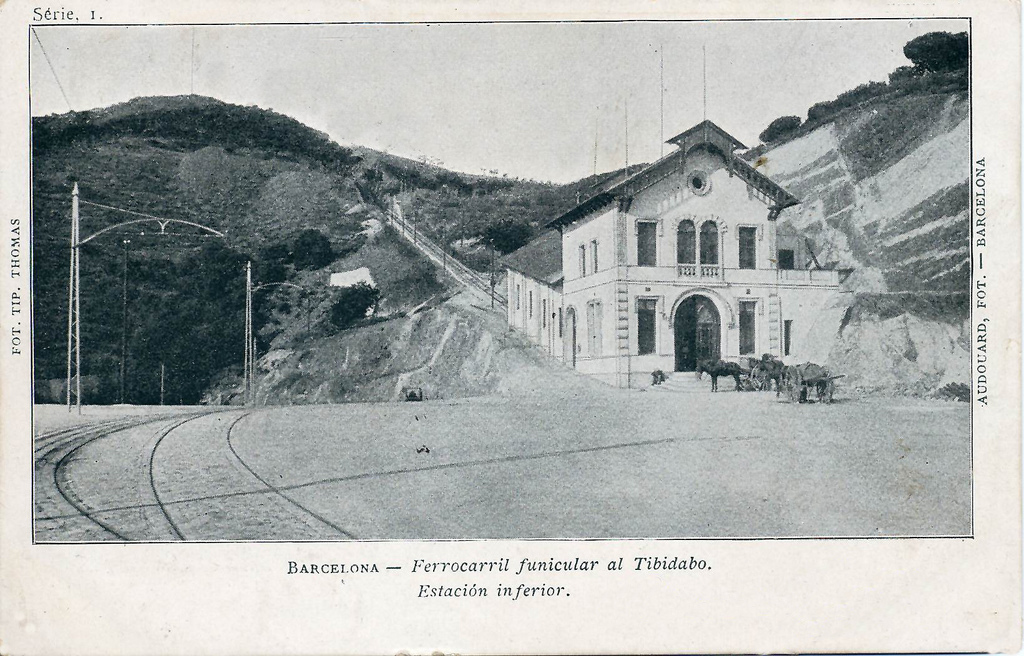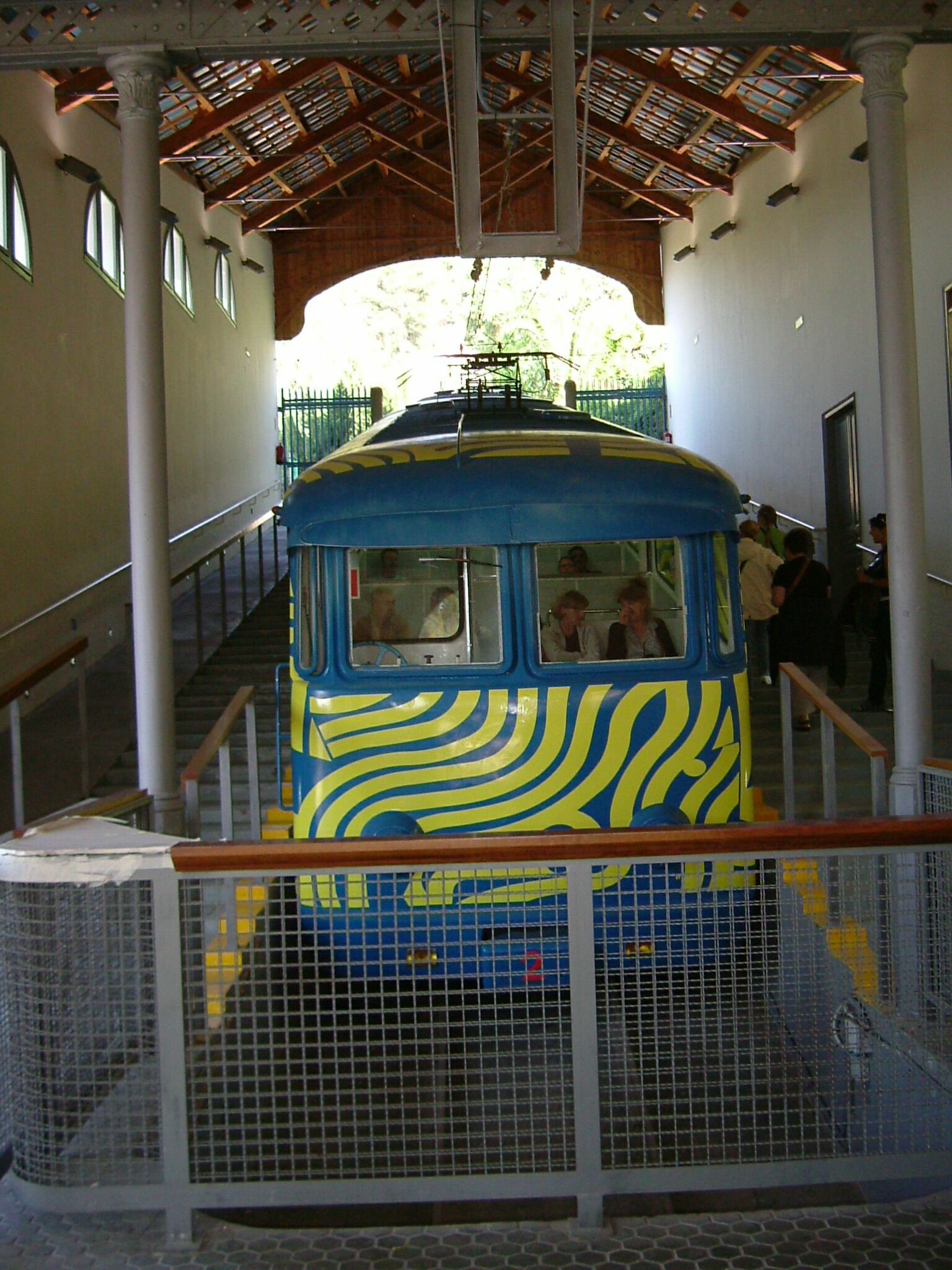|
Funicular De Tibidabo
The Tibidabo Funicular ( ca, Funicular del Tibidabo; es, Funicular del Tibidabo) is a funicular railway in the city of Barcelona, in Catalonia, Spain. The line connects ''Plaça del Doctor Andreu'', the upper terminus of the ''Tramvia Blau'', with the summit of Tibidabo, where there is an amusement park and a church, the Temple Expiatori del Sagrat Cor. The funicular is one of three in Barcelona, the others being the Funicular de Vallvidrera and the Funicular de Montjuïc. After modernisation works the funicular recommenced operations with new trainsets nicknamed "''La'' ''Cuca de llum"'' in June 2021 during a period of upgrade works from 2019. The ''Tramvia Blau'', along with a parallel bus service, provides a connection from Avinguda Tibidabo metro station. This is the terminus of line 7 of the Barcelona Metro, operated by the FGC from a city terminus at Plaça de Catalunya. Like the Tramvia Blau, the funicular is not part of Autoritat del Transport Metropolità The Metr ... [...More Info...] [...Related Items...] OR: [Wikipedia] [Google] [Baidu] |
Barcelona
Barcelona ( , , ) is a city on the coast of northeastern Spain. It is the capital and largest city of the autonomous community of Catalonia, as well as the second most populous municipality of Spain. With a population of 1.6 million within city limits,Barcelona: Población por municipios y sexo – Instituto Nacional de Estadística. (National Statistics Institute) its urban area extends to numerous neighbouring municipalities within the and is home to around 4.8 million people, making it the [...More Info...] [...Related Items...] OR: [Wikipedia] [Google] [Baidu] |
Barcelona Metro
The Barcelona Metro (Catalan and Spanish: ) is an extensive network of rapid transit electrified railway lines that run mostly underground in central Barcelona and into the city's suburbs. It is part of the larger public transport system of Barcelona, the capital of Catalonia, Spain, with unified fares under the (ATM) scheme. As of 2014, the network is operated by two separate companies: (TMB) and (FGC). It is made up of 12 lines, combining the lines owned by the two companies. Two lines, L9 and L10, are being built at present, with both lines having different sections of each opened between 2009 and 2018. They are due to be fully completed in 2026. Three lines on the network have opened as automatic train operation/driverless vehicle systems since 2009: Line 11, Line 9 and Line 10, in chronological order. The network length is , with 183 stations, as of November 2021. History The first rapid transit railway service in Barcelona was founded in 1863 by the pri ... [...More Info...] [...Related Items...] OR: [Wikipedia] [Google] [Baidu] |
Tibidabo Funicular
The Tibidabo Funicular ( ca, Funicular del Tibidabo; es, Funicular del Tibidabo) is a funicular railway in the city of Barcelona, in Catalonia, Spain. The line connects ''Plaça del Doctor Andreu'', the upper terminus of the ''Tramvia Blau'', with the summit of Tibidabo, where there is an amusement park and a church, the Temple Expiatori del Sagrat Cor. The funicular is one of three in Barcelona, the others being the Funicular de Vallvidrera and the Funicular de Montjuïc. After modernisation works the funicular recommenced operations with new trainsets nicknamed "''La'' ''Cuca de llum"'' in June 2021 during a period of upgrade works from 2019. The ''Tramvia Blau'', along with a parallel bus service, provides a connection from Avinguda Tibidabo metro station. This is the terminus of line 7 of the Barcelona Metro, operated by the FGC from a city terminus at Plaça de Catalunya. Like the Tramvia Blau, the funicular is not part of Autoritat del Transport Metropolità The Metr ... [...More Info...] [...Related Items...] OR: [Wikipedia] [Google] [Baidu] |
Grade (slope)
The grade (also called slope, incline, gradient, mainfall, pitch or rise) of a physical feature, landform or constructed line refers to the tangent of the angle of that surface to the horizontal. It is a special case of the slope, where zero indicates horizontality. A larger number indicates higher or steeper degree of "tilt". Often slope is calculated as a ratio of "rise" to "run", or as a fraction ("rise over run") in which ''run'' is the horizontal distance (not the distance along the slope) and ''rise'' is the vertical distance. Slopes of existing physical features such as canyons and hillsides, stream and river banks and beds are often described as grades, but typically grades are used for human-made surfaces such as roads, landscape grading, roof pitches, railroads, aqueducts, and pedestrian or bicycle routes. The grade may refer to the longitudinal slope or the perpendicular cross slope. Nomenclature There are several ways to express slope: # as an ''angle'' of inc ... [...More Info...] [...Related Items...] OR: [Wikipedia] [Google] [Baidu] |
Passing Loop
A passing loop (UK usage) or passing siding (North America) (also called a crossing loop, crossing place, refuge loop or, colloquially, a hole) is a place on a single line railway or tramway, often located at or near a station, where trains or trams travelling in opposite directions can pass each other. Trains/trams going in the same direction can also overtake, provided that the signalling arrangement allows it. A passing loop is double-ended and connected to the main track at both ends, though a dead end siding known as a refuge siding, which is much less convenient, can be used. A similar arrangement is used on the gauntlet track of cable railways and funiculars, and in passing places on single-track roads. Ideally, the loop should be longer than all trains needing to cross at that point. Unless the loop is of sufficient length to be dynamic, the first train to arrive must stop or move very slowly, while the second to arrive may pass at speed. If one train is too long for ... [...More Info...] [...Related Items...] OR: [Wikipedia] [Google] [Baidu] |
Single Track (rail)
A single-track railway is a railway where trains traveling in both directions share the same track. Single track is usually found on lesser-used rail lines, often branch lines, where the level of traffic is not high enough to justify the cost of constructing and maintaining a second track. Advantages and disadvantages Single track is significantly cheaper to build and maintain, but has operational and safety disadvantages. For example, a single-track line that takes 15 minutes to travel through would have capacity for only two trains per hour in each direction safely. By contrast, a double track with signal boxes four minutes apart can allow up to 15 trains per hour in each direction safely, provided all the trains travel at the same speed. This hindrance on the capacity of a single track may be partly overcome by making the track one-way on alternate days, if the single track is not used for public passenger transit. Long freight trains are a problem if the passing s ... [...More Info...] [...Related Items...] OR: [Wikipedia] [Google] [Baidu] |
Autoritat Del Transport Metropolità
The Metropolitan Transport Authority ( ca, Autoritat del Transport Metropolità, ATM) is a public consortium intended to coordinate the operation and project the expansion of the public transport system in the Barcelona metropolitan area. It is made up of the Government of Catalonia and local administrations. It has been known as ATM ''Àrea de Barcelona'' since 2003 to differentiate it from the other existing Catalan public transport authorities in the Girona, Camp de Tarragona and Lleida areas, which are also identified as ''ATM''. , the ATM-managed public transport system comprises 50 different operating companies and serves 346 municipalities, accounting for a population of over 5.7 million. Created in 1997, the ATM has since developed an Integrated Fare System ( ca, Sistema Tarifari Integrat, STI) based on concentric fare zones. There currently exist about 80 different types of multiple-time tickets or unlimited passes for use on the STI, all of which allow free-of-charg ... [...More Info...] [...Related Items...] OR: [Wikipedia] [Google] [Baidu] |
Ferrocarrils De La Generalitat De Catalunya
Ferrocarrils de la Generalitat de Catalunya (, "Catalan Government Railways"), or FGC, is a railway company which operates several unconnected lines in Catalonia, Spain. The lines operated include metro and commuter lines in and around the city of Barcelona, tourist mountain railways, and rural railway lines. They include of gauge route, of route, of route, and of broad gauge route, making the FGC one of the few railway companies to operate on four different gauges. Whilst most lines are conventional adhesion railways, the FGC also operates two rack railways and four funicular railways. In 2018, the network carried 87.2 million passengers. History FGC was founded on 5 September 1979 to manage lines whose ownership was transferred from the state-owned FEVE to the Generalitat of Catalonia in 1978 as part of the process of regional devolution under the Spanish Constitution of 1978. Its oldest line, the standard gauge '' Línia Barcelona-Vallès'' however dates back to 18 ... [...More Info...] [...Related Items...] OR: [Wikipedia] [Google] [Baidu] |
Barcelona Metro Line 7
Barcelona ( , , ) is a city on the coast of northeastern Spain. It is the capital and largest city of the autonomous community of Catalonia, as well as the second most populous municipality of Spain. With a population of 1.6 million within city limits,Barcelona: Población por municipios y sexo – Instituto Nacional de Estadística. (National Statistics Institute) its urban area extends to numerous neighbouring municipalities within the and is home to around 4.8 million people, making it the [...More Info...] [...Related Items...] OR: [Wikipedia] [Google] [Baidu] |
Tramvia Blau
The Tramvia Blau (Catalan for "blue tramway") is one of Barcelona's three tram systems. It is a long heritage streetcar line serving a hilly area of the Sarrià-Sant Gervasi district between the terminus of FGC Barcelona Metro L7 and the Funicular del Tibidabo. The Tramvia Blau is operated by Transports Metropolitans de Barcelona (TMB) but it is not part of Autoritat del Transport Metropolità (ATM) integrated fare network. Tickets must be purchased from the tram conductor. The Tramvia Blau is one of only two first generation tramways to survive in Spain, along with the Tranvía de Sóller on the island of Majorca. The Tibidabo tramway has been closed for reconstruction since Spring 2018. History The line was built at the instigation of Dr. Salvador Andreu, who was building a residential project around the axis of the Tibidabo Avenue, and was inaugurated in 1901. The line connected at ''Plaça Kennedy'' with trams of Barcelona's city system, but was independently owned. The ... [...More Info...] [...Related Items...] OR: [Wikipedia] [Google] [Baidu] |






